
Chris Wilcox, special assistant professor of computer science, talks to students in the first Summer Programming Camp for Middle School Girls.
Dharini has never had a blog before, but she has always wanted one. Thanks to CSU’s first Summer Programming Camp for Middle School Girls, this local student now has one. It’s not hosted by WordPress or Tumblr. She built it herself, from scratch, one HTML phrase at a time – as did each of her five classmates.
The camp, led by Chris Wilcox, special assistant professor of computer science in the College of Natural Sciences, ran concurrently last week with the also-new Summer STEM Camp for Women in Fort Collins (SWiFT) for high schoolers, led by Sangmi Pallickara, an assistant professor of computer science.
Across the U.S., fewer than one in five computer science bachelor’s degrees goes to a woman. This disparity continues up into high-level tech companies (where some of the best-paying jobs reside). And the gender gap often starts long before students arrive on college campuses.
Approximately 95 percent of U.S. high schools lack computer science programs, Pallickara says. By the time they start college, many women have already gravitated to other disciplines. So with these camps, she says, “the goal is to expose them to this field – and encourage them to explore it.”
Starting from Scratch
The six rising sixth through ninth graders in Wilcox’s camp spent their week learning the joys of computing, in part by building their own, personalized webpages using HTML and CSS. These pages, created over just a couple days, feature each girl’s interests and personalities. They include text, snazzy backgrounds and lots and lots of pictures (softball, cupcakes, baby penguins) – even embedded videos.

By day three, the girls had moved on to building their own dynamic games in the simple programming language known as Scratch. In Scratch, they can customize characters, movement and even the music. (In Hannah’s Scratch game, for example, a cat soars through the nighttime sky, aiming to collect as many flying doughnuts (10 points) and tacos (20 points) – while dodging point-sapping fortune cookies.) They picked the program up quickly, Wilcox says. “One of the girls was better at Scratch than me, but I think I caught up!” he says. Their speed meant that they got to move on to creating programs in the more advanced language of Python, which, says, Wilcox, “I hadn’t planned on.”
The activities were fun and colorful and personal, and the students were proud to show off their creations. Through the process, they learned that the work takes creativity, as well as attention to detail. “It’s really picky,” says one student named Gemma, of HTML. “Like, if you put in an extra space, it won’t run.” She built an instructional webpage about baking, her favorite hobby – at least up until now.
Wilcox, along with an undergraduate computer science student and a Fort Collins high school student from the Girls Who Code club, were on hand to patiently guide students through. And Wilcox, who worked in the industry for decades before coming to CSU to get his Ph.D. and teach, also provided the girls with an inside look at what it means to major – and get a rewarding job – in computer science.
Smart data
In Pallickara’s week-long day camp – free for students, funded by her recent NSF CAREER Award – 10 rising juniors from Rocky Mountain High School learned Unix, Python, data modeling and how to create a program that analyzes content on social media streams.
One afternoon, for example, the students worked in groups to code an analysis of sentiment surrounding popular topics on Twitter. One team investigated athletic brands, another new-release movies, and another (who called themselves the French Toast Mafia) predicted current political poll outcomes based on Tweets about Hillary Clinton and Donald Trump. In the process, they learned about the challenges of visually representing data – and the occasional pitfalls of computer analysis of human (a.k.a. “natural”) language. They created presentations about their findings and processes that they will share with classmates back at school in the fall.
If all of this sounds like a lot of material for five days, it is. Especially for a group for whom most of this was new territory. Before the program, Pallickara says, “the students were not really familiar with this content.” In fact, nine out of the 10 had never programmed at all before.
But, says Pallickara, she and her colleagues crafted the curriculum around math courses the girls have taken in school to help connect the dots; the camp also had almost as many mentors and instructors as it did students. And by day two, the campers were building games in Python. To see the young women taking off on their latest programming challenge, said Pallickara, “it’s really exciting.”